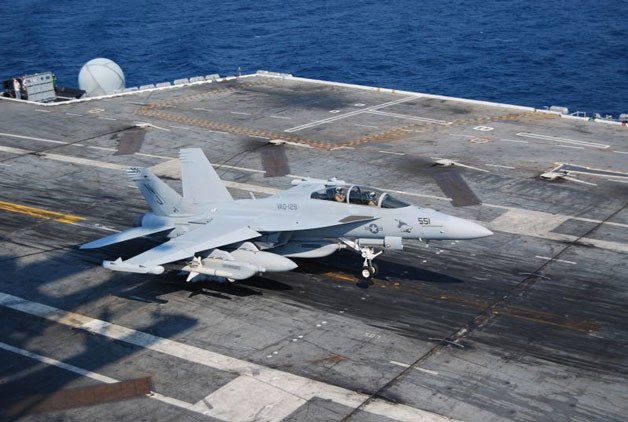A Coupeville-based group that sued the Navy in July over jet noise is claiming that Outlying Field Coupeville is not as essential as the Navy claims.
The Navy suspended touch-and-go operations at OLF Coupeville in May, but plans to resume in January in a more limited capacity than in recent years.
The landing practice field is part of Whidbey Island Naval Air Station.
After temporarily suspending practices at OLF Coupeville, the Navy shifted some training for the EA-18G Growler to Ault Field and El Centro Naval Air Facility in California.
“Although the Navy has insisted that its outlying field next to Ebey’s National Reserve in Coupeville is an ‘essential adjunct’ of Whidbey Island’s Naval Air Station, the controversial World War II runway is not as essential as the Navy claims,” Michael Monson said in a news release this week on behalf of the Coupeville-based Citizens of Ebey’s Reserve, or COER, the group that filed the lawsuit.
“Clearly, the Navy can conduct its noisy practicing at an ‘elsewhere’ OLF.”
The Navy is in the beginning stages of conducting a new environmental study on the impacts of the Growler, which is replacing the Navy’s EA-6B Prowler.
COER members say that the Growler is louder than its predecessor. Navy representatives said recently that the noise from the two aircraft is similar, but may seem louder due to differing frequency levels.
Critics also say the Navy exceeded the number of operations it estimated would be needed at OLF.
Capt. Mike Nortier, commanding officer at NAS Whidbey, conceded the Navy did exceed its projections during 2011 and 2012.
According to Environ-mental Assessments completed in 2005 and 2012, the Navy anticipated flying about 6,120 operations at OLF and 18,282 at Ault Field.
Because of mission requirements, however, the Navy performed 9,378 at OLF Coupeville in 2011, and 9,668 in 2012, Nortier said.
Nortier said NAS Whidbey suspended operations at the outlying field in May 2013 because it again exceeded the estimate with 6,972 operations completed.
Moving forward, it is the Navy’s intention to stay within the 6,120 operations annually at OLF until the current environmental study is completed in 2016, Nortier said.
While the Navy met some of its Growler training needs at other locations, “that’s not sustainable for the long term,” said Rick Meyer with U.S. Fleet Forces Aviation Shore Readiness.
Growler pilots are only trained at El Centro if they happened to be deployed there, he said.
It is unlikely that a complete closure of OLF Coupeville will be considered in the environmental study, Meyer said.
COER members say they are unconvinced that the Navy will keep operations to the estimated 6,120 and will not be satisfied until land practices are moved elsewhere.
“Why should we believe them?” Monson said. “During this period they have proven we don’t need OLF. If they say otherwise, it’s hogwash.”
Monson said there was a time when his group would have accepted the 6,120 operations, but that the Navy has already had “three strikes.”
“If they had stuck with their 2005 projections, this stick would not have been raised,” Monson said.
The new Growler study aims to evaluate the potential environmental effects associated with ongoing EA-18G Growler airfield operations at NAS Whidbey’s Ault Field and OLF Coupeville, including the proposed introduction of two additional expeditionary electronic attack squadrons and the addition of aircraft to the fleet replacement squadron.

Lisa Padgett, U.S. Fleet Forces Command project manager for the study, said the Growler study is “very early in the process” and that the public will have opportunity to give input now, and again in 2015 when the scoping period nears its conclusion.
The purpose of a recent series of community meetings is for the Navy to listen to the community, she said, adding all feedback will be compiled into the 2015 document for review.
The scoping process will be used to identify community concerns and local issues to be addressed in the EIS. As part of the public involvement during scoping the Navy hosted three open house information sessions.
Comments may be mailed to EA-18G EIS Project Manager (Code EV21/SS), Naval Facilities Engineering Command (NAVFAC) Atlantic, 6506 Hampton Blvd., Norfolk, VA 23508 or submitted via the project website at www.whidbeyeis.com
Deadline is Jan. 3.


